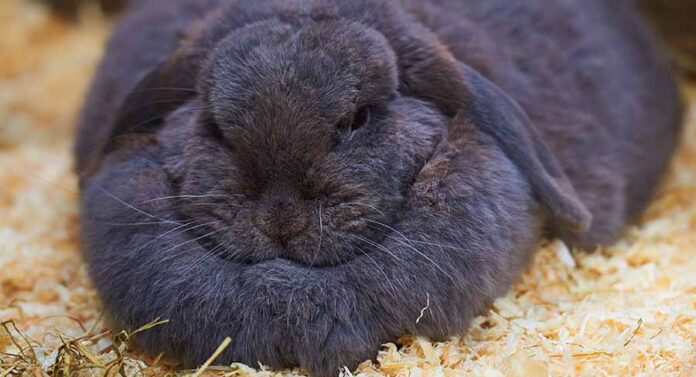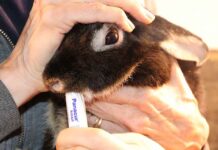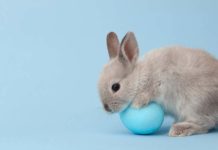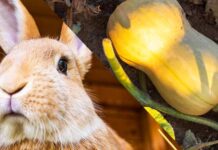Would you describe your bunny as a dewlap rabbit? This article is all about rabbit neck fat – which rabbits have it, why they get it, and how to make sure it doesn’t interfere with their health. Just some of the questions we’ll answer include:
- What is a dewlap on a rabbit?
- When do rabbits develop dewlaps?
- Do all female rabbits have dewlaps?
- Is my bunny overweight?
- How to get rid of a rabbits dewlap
A dewlap is a fold of fatty tissue underneath a rabbit’s chin. Not all rabbits have one, but for those females that do, it has a special role to play in raising young. If your rabbit has a big dewlap, you’ll need to know about dewlap-specific health problems, and how to recognize and treat them.
These mighty Flemish Giant rabbits have substantial dewlaps – let’s find out exactly what they’re for!
What is a dewlap on a rabbit?
A bunny’s dewlap (pronounced ‘DOO-lap’ or ‘DYOO-lap’, depending on your region) is a fold of fatty tissue and skin just beneath their chin. Dewlaps vary in size depending on a rabbit’s age, breed, neuter status and body condition. Small dewlaps are little more than a pouchy bit of fur, whilst large dewlaps look more like a bulky fur bib, or built-in napping pillow! They are a normal part of rabbit anatomy, and a big dewlap doesn’t necessarily mean there is anything medically wrong with your rabbit. However, dewlaps which are naturally very large, or have become large through obesity can be prone to some specific complications, which we’ll look at in a moment.
But first, why do rabbits have dewlaps anyway, and can any rabbit grow one?
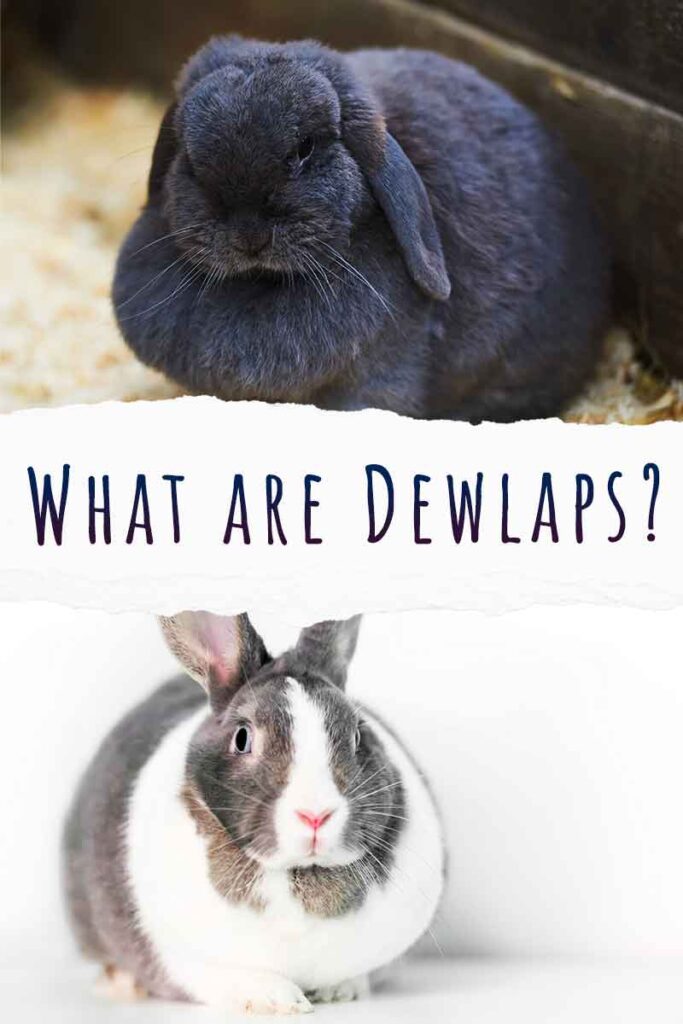
The purpose of the bunny dewlap
Rabbit dewlaps originally evolved as a convenient, accessible site for pregnant does to pluck fur for their nests. Rabbits’ fur is soft, dense, and excellent at trapping warm air amongst its fibers. In fact, it is the perfect nesting material for a litter of newborn rabbit kittens, to insulate them before they’re big enough to generate sufficient body heat of their own, and ensure their survival. So, female rabbits have adapted to release hormones during pregnancy, which loosen their hairs at the root. This makes it easy and painless to pluck out enough to line a comfy nest. Rabbit does from all breeds remove fur from their belly and sides, and if they have one, their dewlap. So the dewlap is just another convenient site to find nesting material from.
When do rabbits develop dewlaps?
Since the function of the female rabbit dewlap is linked to procreation, you won’t be surprised to hear that they develop during puberty, to coincide with reaching sexual maturity and being ready to mate for the first time.
The development of the bunny dewlap is linked to the presence of the sex hormone estrogen. Baby rabbits (called kits) are born without a dewlap, and they produce negligible estrogen, so they remain dewlap-less until the onset of adolescence at around 3 to 4 months old. During puberty, female rabbits start producing estrogen, which stimulates development of the dewlap. Does spayed before puberty starts tend to end up with smaller dewlaps, because estrogen is primarily produced in the ovaries after puberty has started. Spaying before puberty removes the primary source of estrogen in their bodies before they can really get up and running. Conversely, unspayed females tend to have the largest dewlaps.
Can a dewlap disappear on a doe rabbit?
Once a female rabbit dewlap has developed, it won’t go away if she is spayed later. As we’ll see later though, it could vary in size over her lifetime if she gains and/or loses weight.
Do all female rabbits have dewlaps?
Whilst dewlaps are more commonly seen on female bunnies, not all does have one. We’ve already seen how spaying before puberty can stop or impede the development of a dewlap. But her breed is also significant. Some breeds have more pronounced dewlaps than others – in fact some rabbits’ breed standard even specifically stipulate that rabbits in that breed should, or should not, have a dewlap.
For example, the Flemish Giant breed standard says that does shall have a dewlap which is carried evenly, and it may even be large and full. Permitted and encouraged dewlaps are also common for other large breeds (such as the Californian) and also the lop eared breeds (such as the Mini Lop and the Holland Lop).
Other breeds are allowed to have a dewlap in show condition, but it shouldn’t be too pronounced. For example a Rex rabbit dewlap shouldn’t be ‘excessive’.
Finally, some rabbit breeds explicitly should not have dewlaps, and may be excluded from rabbit shows if they do. Popular examples include the Netherland Dwarf rabbit, and the Dwarf Hotot.
Male dewlap rabbit
Despite the connection to estrogen, dewlaps aren’t the sole preserve of female bunnies. Small but significant amounts of estrogen are produced by male mammals too, and this causes some male rabbits to develop a dewlap. But, it rarely becomes as prominent as a doe’s!
Neutering a male rabbit before puberty is linked to growing a more pronounced dewlap. This is because early neutering changes the balance of hormones in their body, and makes the role of estrogen more significant.
Is my bunny overweight?
A dewlap is made up of fatty tissue, but it doesn’t necessarily mean that a rabbit with a big dewlap is overweight. However, an overweight rabbit is likely to have an oversized dewlap. If your dewlap rabbit starts to carry more weight, the size of their dewlap can start to interfere with activities like eating, drinking and grooming.
Rather than relying on the size of their dewlap (which is naturally fatty) to judge whether they are overweight, gently try to feel their ribs, spine and hip bones with flattened hands. If you can’t feel them easily, or if their stomach sags onto the ground, then they may be overweight. Ask a veterinarian to confirm your diagnosis, and help you plan a safe weight-loss regime.
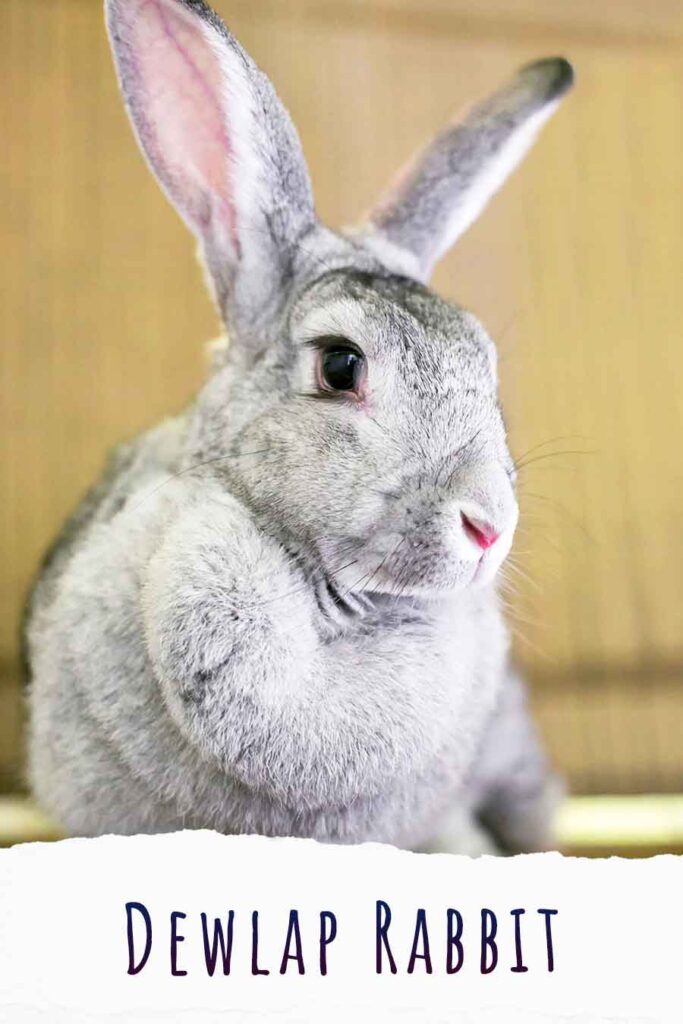
Caring for a dewlap bunny
An exaggerated dewlap is normal for lots of female rabbits, especially if their show standard favors prominent neck folds. But there are some practical aspects of dewlap care to bear in mind.
Grooming
A large dewlap can get in the way of a rabbit being able to groom themselves efficiently. Especially if coupled with long hair, or obesity. Since dirty fur is a magnet for flies, which can lay their eggs and leave flesh-maggots on your bunny’s skin, it’s important to make sure your rabbit stays clean and groomed at all times. If you notice your bunny missing areas on their belly or flanks, step in and help them out, every day.
Wetness
Wet dewlap is exactly what it sounds like. When the fur on a bunny’s dewlap gets wet and stays wet for prolonged periods, the skin beneath it can become inflamed and irritated. The damaged skin in turn becomes a gateway for fungal or bacterial infection to enter the body. Wet dewlap can be caused by:
- drinking from a water bowl rather than a bottle
- drinking from a leaking water bottle
- or drinking from a water bottle mounted at the wrong height.
But it’s also a sign of some other underlying problems, including:
- dental problems which are causing the rabbit to drool
- or being overweight and having an excessively large dewlap.
If your rabbit has persistent wet fur on their dewlap, check their drinking arrangements and their teeth. If they are drooling excessively, or the skin under the wet fur is showing any signs of inflammation, take them to the vet.
Lump under rabbit’s chin
Facial abscesses (pus-filled lumps) are a common problem in rabbits. Having a substantial dewlap doesn’t make a rabbit more at risk of facial abscesses, but it can make one on the lower jaw harder to spot in the early stages. Handling and interacting with your rabbit every day makes it more likely that you’ll spot a developing abscess early on. All new lumps and bumps on a bunny need prompt veterinary attention.
How to get rid of a rabbits dewlap
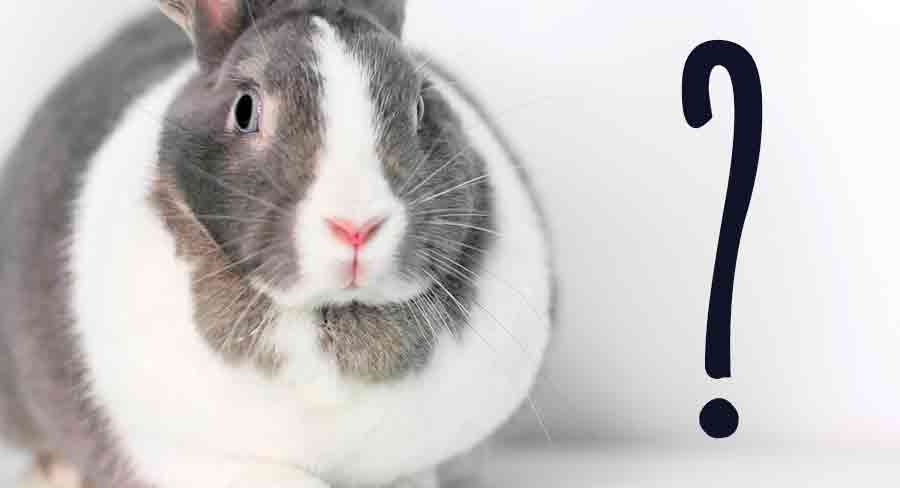
A dewlap is a normal feature of lots of rabbits. There is no justification for removing it for cosmetic reasons alone. In extreme cases, a veterinarian may recommend surgically reducing the size of a rabbit’s dewlap if they are a healthy weight and it is still large enough to interfere with their welfare. However, this decision needs to be balanced against the risks of surgery and placing the bunny under general anesthetic – so it’s usually a last resort.
Dewlap rabbit summary
Dewlap rabbits look like they have a built in pillow for resting their chin on! But that rabbit double chin serves a useful purpose by providing a source of soft nesting material for pregnant does. The presence or absence of a dewlap is influenced by the sex and breed of the rabbit, and their neuter status. An overweight rabbit might also have an overly large dewlap. If your rabbit has a naturally impressive dewlap, remember to pay attention to it as part of their daily care.
Does your rabbit have a dewlap?
Tell us about them in the comments box down below!
Before you go, you might also enjoy some of these articles:
- Flemish Giant Rabbits
- Californian Rabbit Breed – Your Guide To The California White Bunny
- How Big Do Rex Rabbits Get?
- Choosing the Best Rabbit Grooming Brush
- Best Small Pets for Cuddling
- Jersey Wooly Rabbit
References
American Rabbit Breeders Association
Bourne. Hay for a healthy rabbit: the importance of appropriate feed. Companion Animal. 2018.
Harcourt-Brown & Chitty. Facial Abscesses. BSAVA Manual of Rabbit Surgery, Dentistry and Imaging. 2013.
Praag & Praag. Chronic wetness of the chin or dewlap in rabbits: non-dental causes. MediRabbit. 2020.
Stapleton. The chubby bunny: a closer look at obesity in the pet rabbit. The Veterinary Nurse. 2014.

